Challenges of Unemployment in Australian Families: Social Work
VerifiedAdded on 2022/12/27
|16
|4115
|44
Essay
AI Summary
This essay delves into the multifaceted issues and challenges experienced by both Aboriginal and non-Aboriginal families in Australia, focusing on the social, political, and economic consequences of unemployment. It examines the rising rates of family unemployment, particularly in the context of income inequality and the impacts on family welfare, including financial pressures and family conflict. The essay explores the barriers faced by Indigenous Australians in accessing employment, including lower levels of education, discrimination, and limited job opportunities, highlighting the government policies aimed at addressing these disparities. Furthermore, it analyzes the role of social workers in navigating these challenges, considering ethical frameworks and interventions, as well as the impact of broader economic and demographic trends, such as population ageing and changes in the employment sector. The essay concludes by emphasizing the importance of market-driven public services and the need for effective strategies to support jobseekers and employers, ultimately aiming to improve employment outcomes and promote sustainable lifestyles for all Australian families. The essay discusses the role of social workers and the challenges they face in the welfare system.
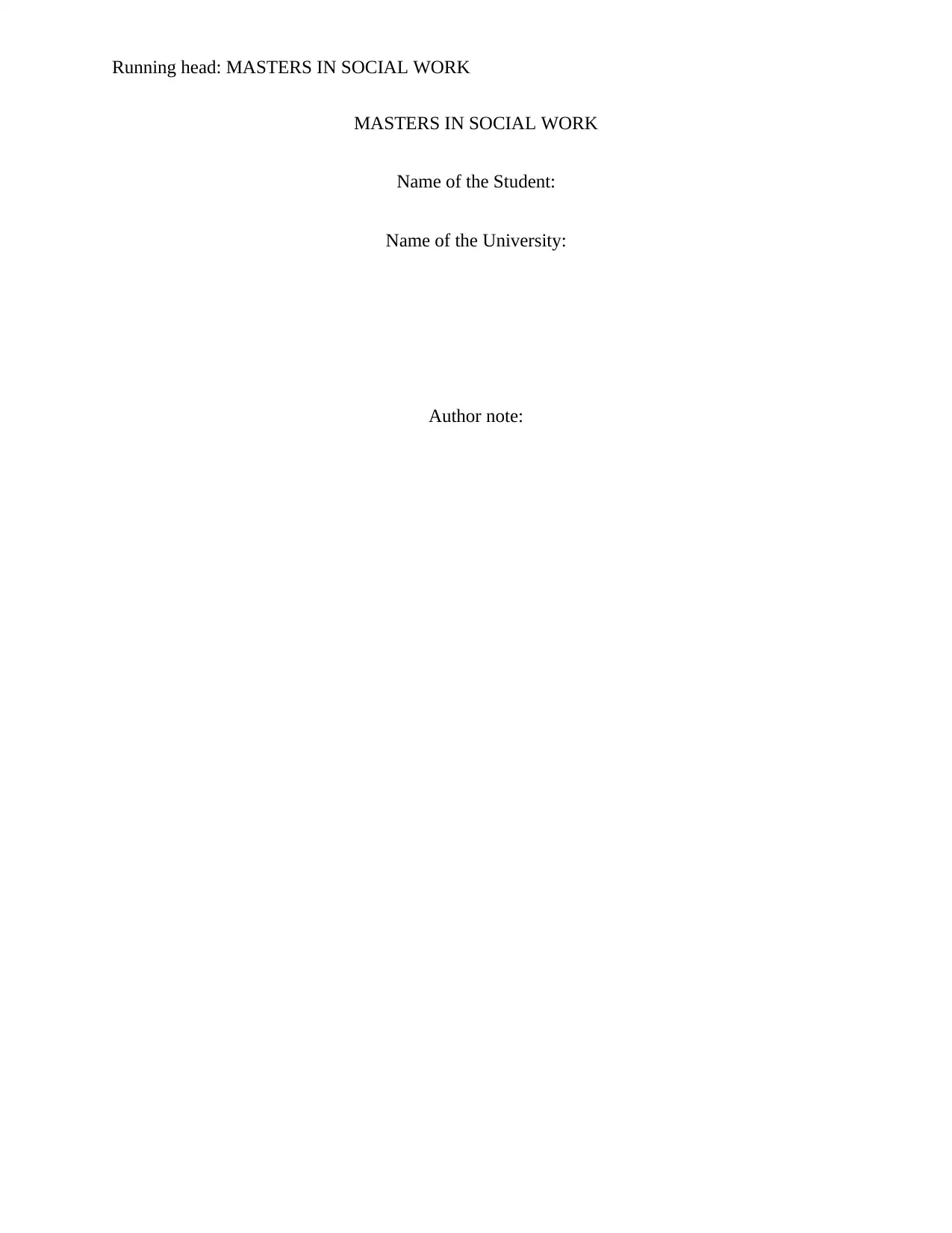
Running head: MASTERS IN SOCIAL WORK
MASTERS IN SOCIAL WORK
Name of the Student:
Name of the University:
Author note:
MASTERS IN SOCIAL WORK
Name of the Student:
Name of the University:
Author note:
Paraphrase This Document
Need a fresh take? Get an instant paraphrase of this document with our AI Paraphraser
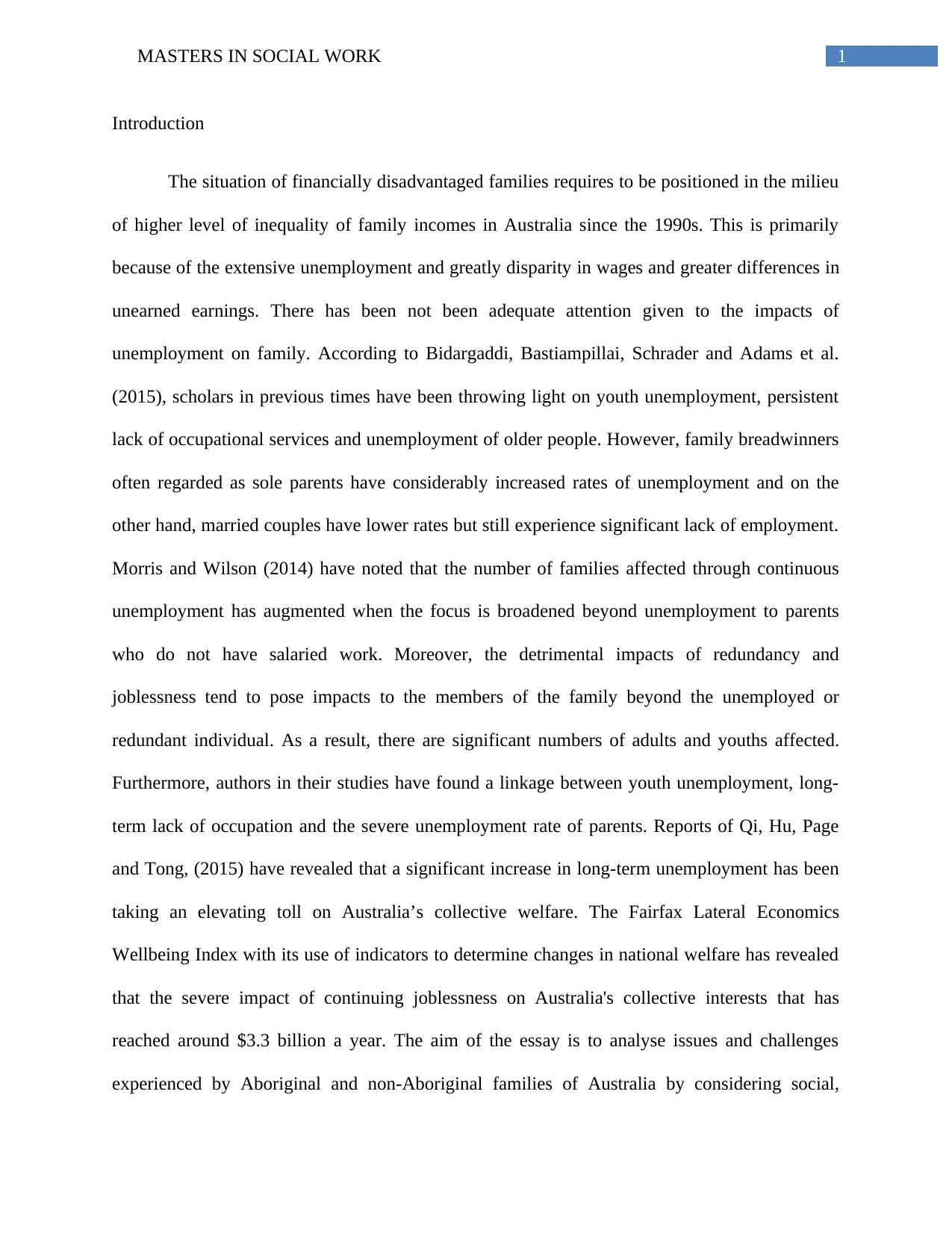
1MASTERS IN SOCIAL WORK
Introduction
The situation of financially disadvantaged families requires to be positioned in the milieu
of higher level of inequality of family incomes in Australia since the 1990s. This is primarily
because of the extensive unemployment and greatly disparity in wages and greater differences in
unearned earnings. There has been not been adequate attention given to the impacts of
unemployment on family. According to Bidargaddi, Bastiampillai, Schrader and Adams et al.
(2015), scholars in previous times have been throwing light on youth unemployment, persistent
lack of occupational services and unemployment of older people. However, family breadwinners
often regarded as sole parents have considerably increased rates of unemployment and on the
other hand, married couples have lower rates but still experience significant lack of employment.
Morris and Wilson (2014) have noted that the number of families affected through continuous
unemployment has augmented when the focus is broadened beyond unemployment to parents
who do not have salaried work. Moreover, the detrimental impacts of redundancy and
joblessness tend to pose impacts to the members of the family beyond the unemployed or
redundant individual. As a result, there are significant numbers of adults and youths affected.
Furthermore, authors in their studies have found a linkage between youth unemployment, long-
term lack of occupation and the severe unemployment rate of parents. Reports of Qi, Hu, Page
and Tong, (2015) have revealed that a significant increase in long-term unemployment has been
taking an elevating toll on Australia’s collective welfare. The Fairfax Lateral Economics
Wellbeing Index with its use of indicators to determine changes in national welfare has revealed
that the severe impact of continuing joblessness on Australia's collective interests that has
reached around $3.3 billion a year. The aim of the essay is to analyse issues and challenges
experienced by Aboriginal and non-Aboriginal families of Australia by considering social,
Introduction
The situation of financially disadvantaged families requires to be positioned in the milieu
of higher level of inequality of family incomes in Australia since the 1990s. This is primarily
because of the extensive unemployment and greatly disparity in wages and greater differences in
unearned earnings. There has been not been adequate attention given to the impacts of
unemployment on family. According to Bidargaddi, Bastiampillai, Schrader and Adams et al.
(2015), scholars in previous times have been throwing light on youth unemployment, persistent
lack of occupational services and unemployment of older people. However, family breadwinners
often regarded as sole parents have considerably increased rates of unemployment and on the
other hand, married couples have lower rates but still experience significant lack of employment.
Morris and Wilson (2014) have noted that the number of families affected through continuous
unemployment has augmented when the focus is broadened beyond unemployment to parents
who do not have salaried work. Moreover, the detrimental impacts of redundancy and
joblessness tend to pose impacts to the members of the family beyond the unemployed or
redundant individual. As a result, there are significant numbers of adults and youths affected.
Furthermore, authors in their studies have found a linkage between youth unemployment, long-
term lack of occupation and the severe unemployment rate of parents. Reports of Qi, Hu, Page
and Tong, (2015) have revealed that a significant increase in long-term unemployment has been
taking an elevating toll on Australia’s collective welfare. The Fairfax Lateral Economics
Wellbeing Index with its use of indicators to determine changes in national welfare has revealed
that the severe impact of continuing joblessness on Australia's collective interests that has
reached around $3.3 billion a year. The aim of the essay is to analyse issues and challenges
experienced by Aboriginal and non-Aboriginal families of Australia by considering social,
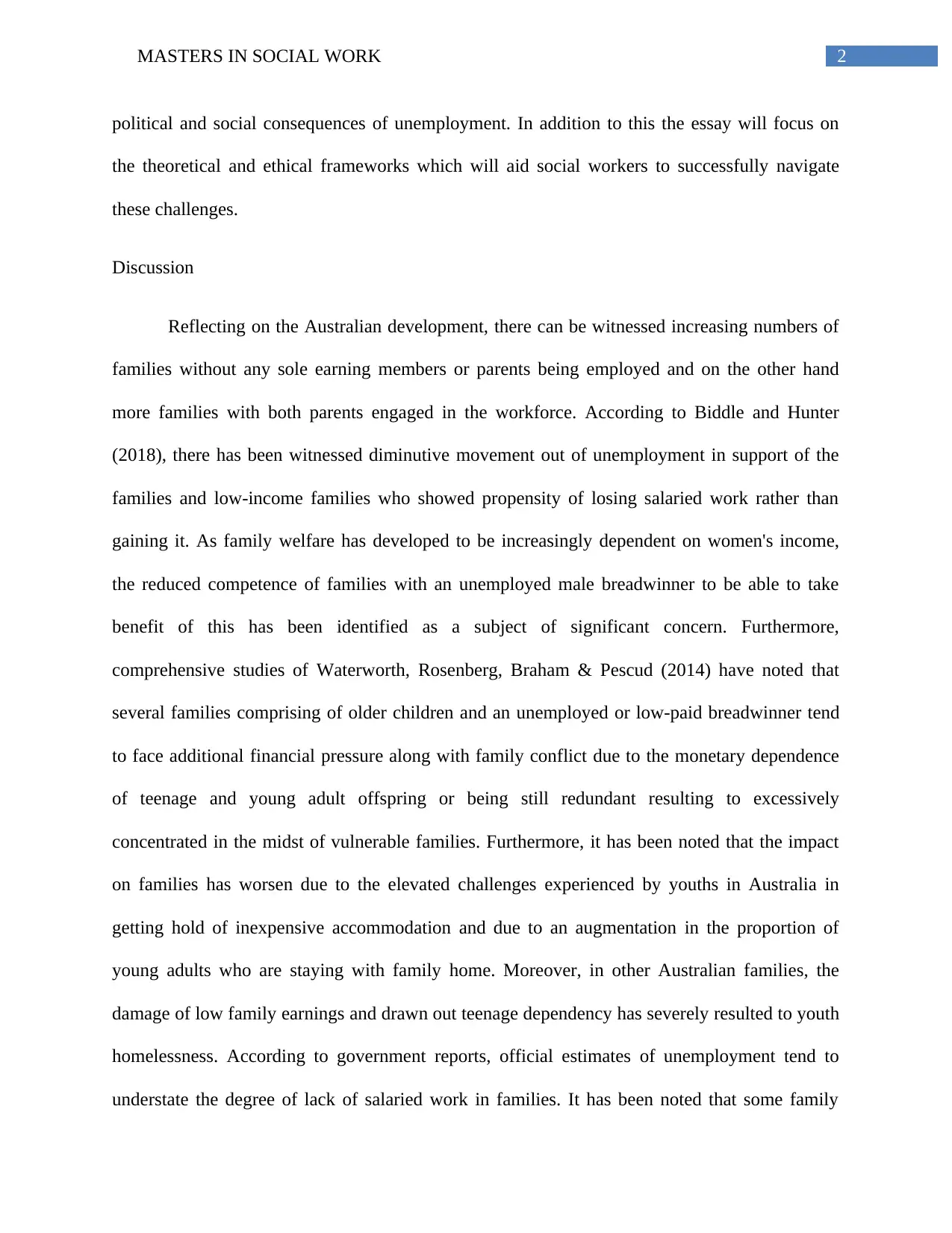
2MASTERS IN SOCIAL WORK
political and social consequences of unemployment. In addition to this the essay will focus on
the theoretical and ethical frameworks which will aid social workers to successfully navigate
these challenges.
Discussion
Reflecting on the Australian development, there can be witnessed increasing numbers of
families without any sole earning members or parents being employed and on the other hand
more families with both parents engaged in the workforce. According to Biddle and Hunter
(2018), there has been witnessed diminutive movement out of unemployment in support of the
families and low-income families who showed propensity of losing salaried work rather than
gaining it. As family welfare has developed to be increasingly dependent on women's income,
the reduced competence of families with an unemployed male breadwinner to be able to take
benefit of this has been identified as a subject of significant concern. Furthermore,
comprehensive studies of Waterworth, Rosenberg, Braham & Pescud (2014) have noted that
several families comprising of older children and an unemployed or low-paid breadwinner tend
to face additional financial pressure along with family conflict due to the monetary dependence
of teenage and young adult offspring or being still redundant resulting to excessively
concentrated in the midst of vulnerable families. Furthermore, it has been noted that the impact
on families has worsen due to the elevated challenges experienced by youths in Australia in
getting hold of inexpensive accommodation and due to an augmentation in the proportion of
young adults who are staying with family home. Moreover, in other Australian families, the
damage of low family earnings and drawn out teenage dependency has severely resulted to youth
homelessness. According to government reports, official estimates of unemployment tend to
understate the degree of lack of salaried work in families. It has been noted that some family
political and social consequences of unemployment. In addition to this the essay will focus on
the theoretical and ethical frameworks which will aid social workers to successfully navigate
these challenges.
Discussion
Reflecting on the Australian development, there can be witnessed increasing numbers of
families without any sole earning members or parents being employed and on the other hand
more families with both parents engaged in the workforce. According to Biddle and Hunter
(2018), there has been witnessed diminutive movement out of unemployment in support of the
families and low-income families who showed propensity of losing salaried work rather than
gaining it. As family welfare has developed to be increasingly dependent on women's income,
the reduced competence of families with an unemployed male breadwinner to be able to take
benefit of this has been identified as a subject of significant concern. Furthermore,
comprehensive studies of Waterworth, Rosenberg, Braham & Pescud (2014) have noted that
several families comprising of older children and an unemployed or low-paid breadwinner tend
to face additional financial pressure along with family conflict due to the monetary dependence
of teenage and young adult offspring or being still redundant resulting to excessively
concentrated in the midst of vulnerable families. Furthermore, it has been noted that the impact
on families has worsen due to the elevated challenges experienced by youths in Australia in
getting hold of inexpensive accommodation and due to an augmentation in the proportion of
young adults who are staying with family home. Moreover, in other Australian families, the
damage of low family earnings and drawn out teenage dependency has severely resulted to youth
homelessness. According to government reports, official estimates of unemployment tend to
understate the degree of lack of salaried work in families. It has been noted that some family
⊘ This is a preview!⊘
Do you want full access?
Subscribe today to unlock all pages.

Trusted by 1+ million students worldwide
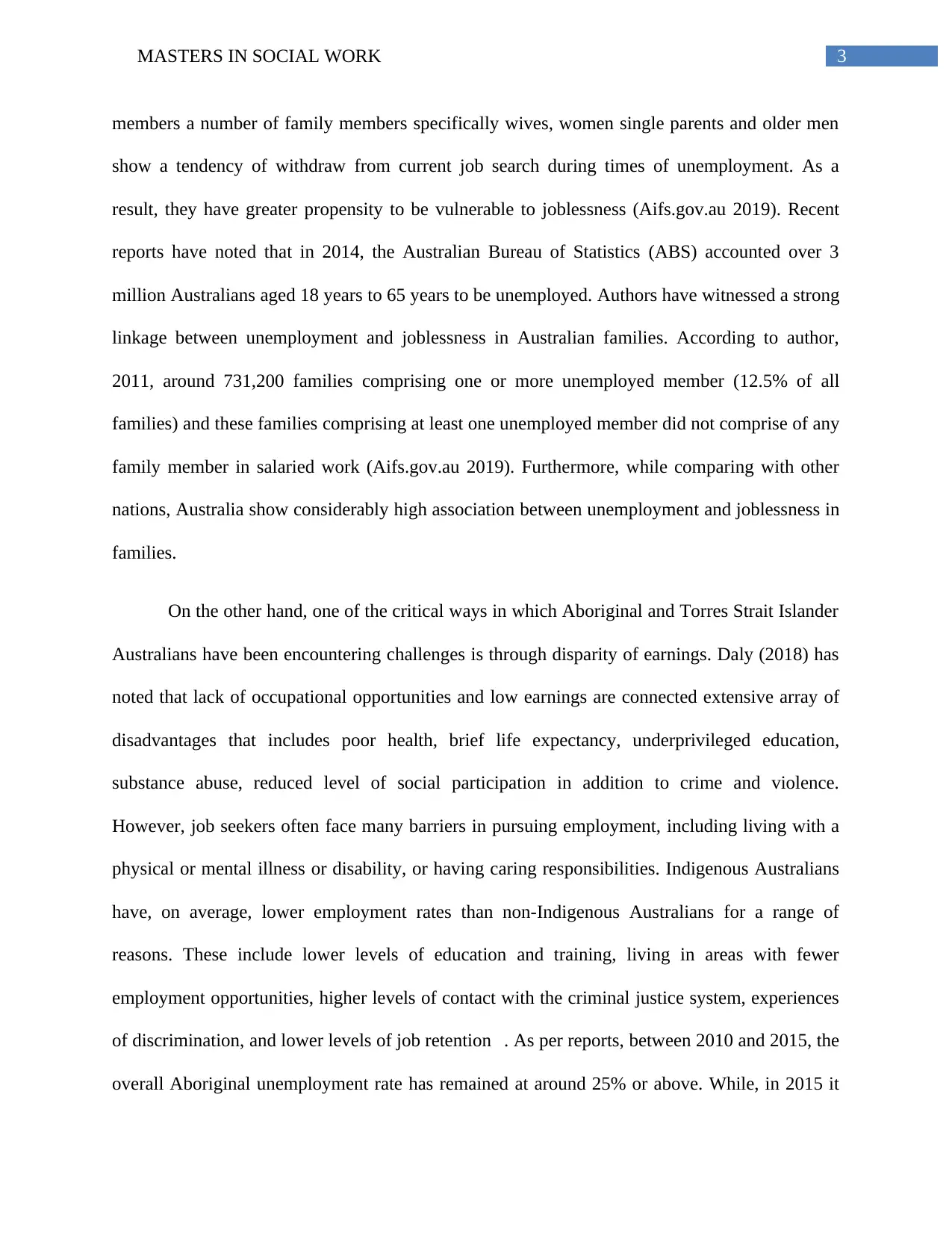
3MASTERS IN SOCIAL WORK
members a number of family members specifically wives, women single parents and older men
show a tendency of withdraw from current job search during times of unemployment. As a
result, they have greater propensity to be vulnerable to joblessness (Aifs.gov.au 2019). Recent
reports have noted that in 2014, the Australian Bureau of Statistics (ABS) accounted over 3
million Australians aged 18 years to 65 years to be unemployed. Authors have witnessed a strong
linkage between unemployment and joblessness in Australian families. According to author,
2011, around 731,200 families comprising one or more unemployed member (12.5% of all
families) and these families comprising at least one unemployed member did not comprise of any
family member in salaried work (Aifs.gov.au 2019). Furthermore, while comparing with other
nations, Australia show considerably high association between unemployment and joblessness in
families.
On the other hand, one of the critical ways in which Aboriginal and Torres Strait Islander
Australians have been encountering challenges is through disparity of earnings. Daly (2018) has
noted that lack of occupational opportunities and low earnings are connected extensive array of
disadvantages that includes poor health, brief life expectancy, underprivileged education,
substance abuse, reduced level of social participation in addition to crime and violence.
However, job seekers often face many barriers in pursuing employment, including living with a
physical or mental illness or disability, or having caring responsibilities. Indigenous Australians
have, on average, lower employment rates than non-Indigenous Australians for a range of
reasons. These include lower levels of education and training, living in areas with fewer
employment opportunities, higher levels of contact with the criminal justice system, experiences
of discrimination, and lower levels of job retention . As per reports, between 2010 and 2015, the
overall Aboriginal unemployment rate has remained at around 25% or above. While, in 2015 it
members a number of family members specifically wives, women single parents and older men
show a tendency of withdraw from current job search during times of unemployment. As a
result, they have greater propensity to be vulnerable to joblessness (Aifs.gov.au 2019). Recent
reports have noted that in 2014, the Australian Bureau of Statistics (ABS) accounted over 3
million Australians aged 18 years to 65 years to be unemployed. Authors have witnessed a strong
linkage between unemployment and joblessness in Australian families. According to author,
2011, around 731,200 families comprising one or more unemployed member (12.5% of all
families) and these families comprising at least one unemployed member did not comprise of any
family member in salaried work (Aifs.gov.au 2019). Furthermore, while comparing with other
nations, Australia show considerably high association between unemployment and joblessness in
families.
On the other hand, one of the critical ways in which Aboriginal and Torres Strait Islander
Australians have been encountering challenges is through disparity of earnings. Daly (2018) has
noted that lack of occupational opportunities and low earnings are connected extensive array of
disadvantages that includes poor health, brief life expectancy, underprivileged education,
substance abuse, reduced level of social participation in addition to crime and violence.
However, job seekers often face many barriers in pursuing employment, including living with a
physical or mental illness or disability, or having caring responsibilities. Indigenous Australians
have, on average, lower employment rates than non-Indigenous Australians for a range of
reasons. These include lower levels of education and training, living in areas with fewer
employment opportunities, higher levels of contact with the criminal justice system, experiences
of discrimination, and lower levels of job retention . As per reports, between 2010 and 2015, the
overall Aboriginal unemployment rate has remained at around 25% or above. While, in 2015 it
Paraphrase This Document
Need a fresh take? Get an instant paraphrase of this document with our AI Paraphraser
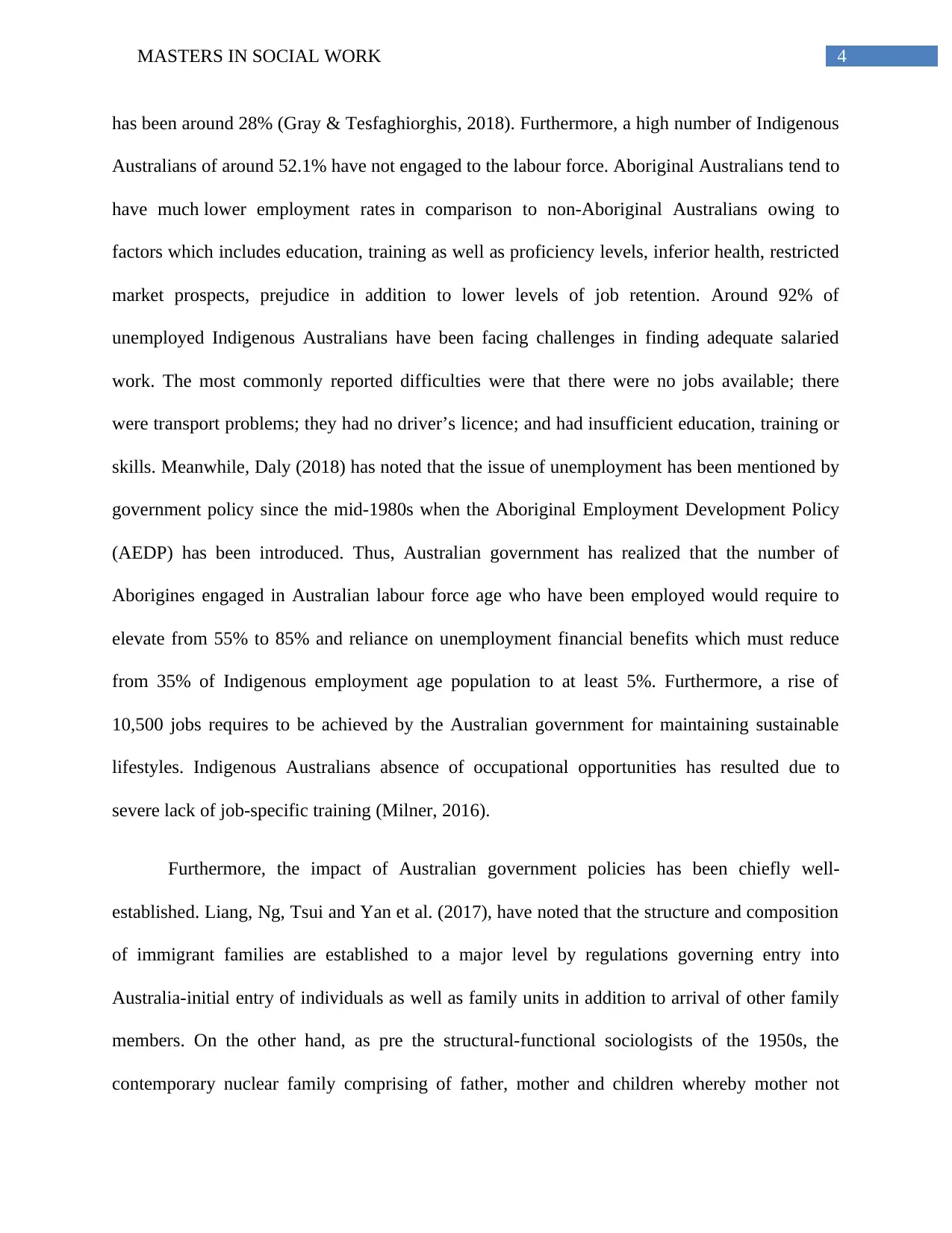
4MASTERS IN SOCIAL WORK
has been around 28% (Gray & Tesfaghiorghis, 2018). Furthermore, a high number of Indigenous
Australians of around 52.1% have not engaged to the labour force. Aboriginal Australians tend to
have much lower employment rates in comparison to non-Aboriginal Australians owing to
factors which includes education, training as well as proficiency levels, inferior health, restricted
market prospects, prejudice in addition to lower levels of job retention. Around 92% of
unemployed Indigenous Australians have been facing challenges in finding adequate salaried
work. The most commonly reported difficulties were that there were no jobs available; there
were transport problems; they had no driver’s licence; and had insufficient education, training or
skills. Meanwhile, Daly (2018) has noted that the issue of unemployment has been mentioned by
government policy since the mid-1980s when the Aboriginal Employment Development Policy
(AEDP) has been introduced. Thus, Australian government has realized that the number of
Aborigines engaged in Australian labour force age who have been employed would require to
elevate from 55% to 85% and reliance on unemployment financial benefits which must reduce
from 35% of Indigenous employment age population to at least 5%. Furthermore, a rise of
10,500 jobs requires to be achieved by the Australian government for maintaining sustainable
lifestyles. Indigenous Australians absence of occupational opportunities has resulted due to
severe lack of job-specific training (Milner, 2016).
Furthermore, the impact of Australian government policies has been chiefly well-
established. Liang, Ng, Tsui and Yan et al. (2017), have noted that the structure and composition
of immigrant families are established to a major level by regulations governing entry into
Australia-initial entry of individuals as well as family units in addition to arrival of other family
members. On the other hand, as pre the structural-functional sociologists of the 1950s, the
contemporary nuclear family comprising of father, mother and children whereby mother not
has been around 28% (Gray & Tesfaghiorghis, 2018). Furthermore, a high number of Indigenous
Australians of around 52.1% have not engaged to the labour force. Aboriginal Australians tend to
have much lower employment rates in comparison to non-Aboriginal Australians owing to
factors which includes education, training as well as proficiency levels, inferior health, restricted
market prospects, prejudice in addition to lower levels of job retention. Around 92% of
unemployed Indigenous Australians have been facing challenges in finding adequate salaried
work. The most commonly reported difficulties were that there were no jobs available; there
were transport problems; they had no driver’s licence; and had insufficient education, training or
skills. Meanwhile, Daly (2018) has noted that the issue of unemployment has been mentioned by
government policy since the mid-1980s when the Aboriginal Employment Development Policy
(AEDP) has been introduced. Thus, Australian government has realized that the number of
Aborigines engaged in Australian labour force age who have been employed would require to
elevate from 55% to 85% and reliance on unemployment financial benefits which must reduce
from 35% of Indigenous employment age population to at least 5%. Furthermore, a rise of
10,500 jobs requires to be achieved by the Australian government for maintaining sustainable
lifestyles. Indigenous Australians absence of occupational opportunities has resulted due to
severe lack of job-specific training (Milner, 2016).
Furthermore, the impact of Australian government policies has been chiefly well-
established. Liang, Ng, Tsui and Yan et al. (2017), have noted that the structure and composition
of immigrant families are established to a major level by regulations governing entry into
Australia-initial entry of individuals as well as family units in addition to arrival of other family
members. On the other hand, as pre the structural-functional sociologists of the 1950s, the
contemporary nuclear family comprising of father, mother and children whereby mother not
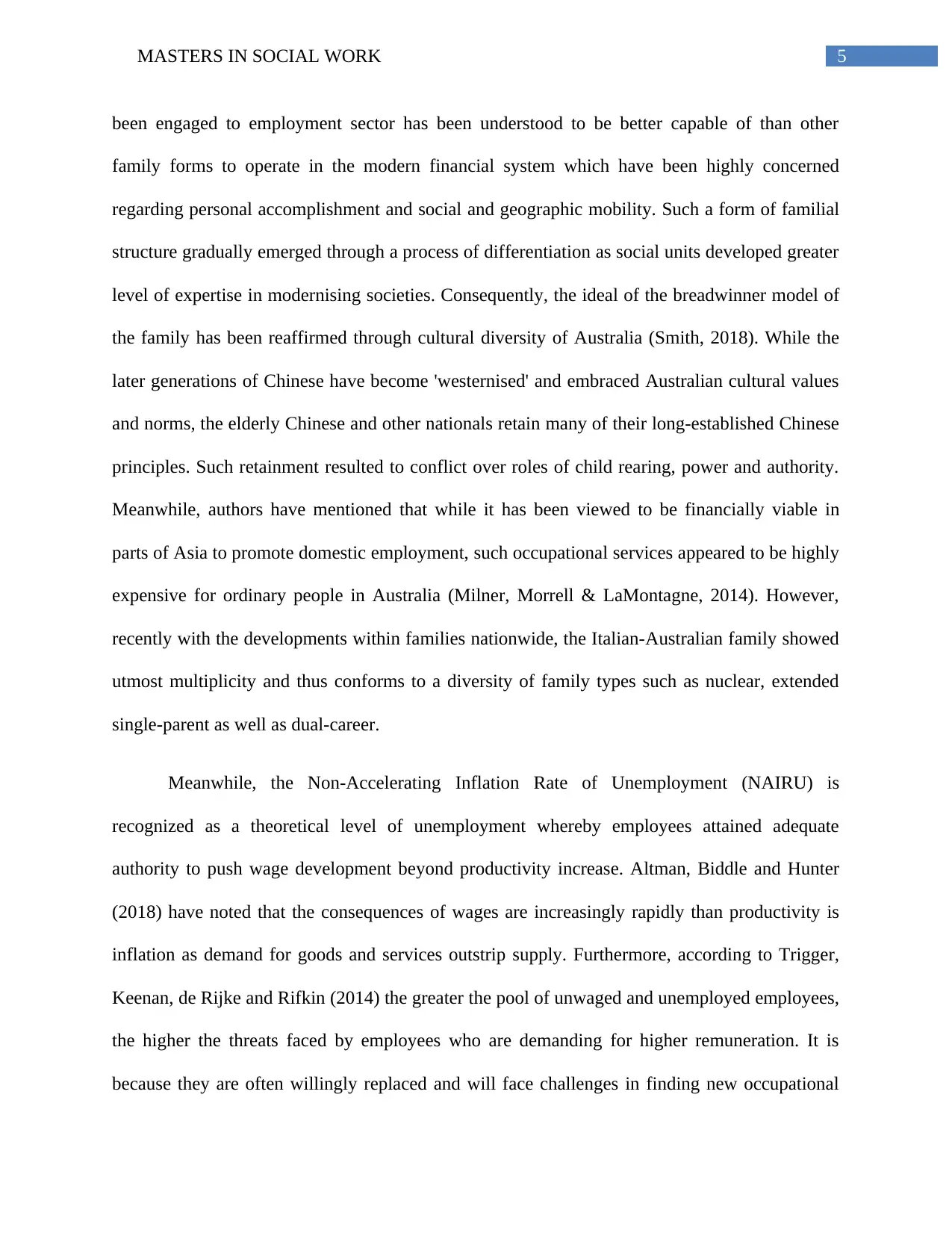
5MASTERS IN SOCIAL WORK
been engaged to employment sector has been understood to be better capable of than other
family forms to operate in the modern financial system which have been highly concerned
regarding personal accomplishment and social and geographic mobility. Such a form of familial
structure gradually emerged through a process of differentiation as social units developed greater
level of expertise in modernising societies. Consequently, the ideal of the breadwinner model of
the family has been reaffirmed through cultural diversity of Australia (Smith, 2018). While the
later generations of Chinese have become 'westernised' and embraced Australian cultural values
and norms, the elderly Chinese and other nationals retain many of their long-established Chinese
principles. Such retainment resulted to conflict over roles of child rearing, power and authority.
Meanwhile, authors have mentioned that while it has been viewed to be financially viable in
parts of Asia to promote domestic employment, such occupational services appeared to be highly
expensive for ordinary people in Australia (Milner, Morrell & LaMontagne, 2014). However,
recently with the developments within families nationwide, the Italian-Australian family showed
utmost multiplicity and thus conforms to a diversity of family types such as nuclear, extended
single-parent as well as dual-career.
Meanwhile, the Non-Accelerating Inflation Rate of Unemployment (NAIRU) is
recognized as a theoretical level of unemployment whereby employees attained adequate
authority to push wage development beyond productivity increase. Altman, Biddle and Hunter
(2018) have noted that the consequences of wages are increasingly rapidly than productivity is
inflation as demand for goods and services outstrip supply. Furthermore, according to Trigger,
Keenan, de Rijke and Rifkin (2014) the greater the pool of unwaged and unemployed employees,
the higher the threats faced by employees who are demanding for higher remuneration. It is
because they are often willingly replaced and will face challenges in finding new occupational
been engaged to employment sector has been understood to be better capable of than other
family forms to operate in the modern financial system which have been highly concerned
regarding personal accomplishment and social and geographic mobility. Such a form of familial
structure gradually emerged through a process of differentiation as social units developed greater
level of expertise in modernising societies. Consequently, the ideal of the breadwinner model of
the family has been reaffirmed through cultural diversity of Australia (Smith, 2018). While the
later generations of Chinese have become 'westernised' and embraced Australian cultural values
and norms, the elderly Chinese and other nationals retain many of their long-established Chinese
principles. Such retainment resulted to conflict over roles of child rearing, power and authority.
Meanwhile, authors have mentioned that while it has been viewed to be financially viable in
parts of Asia to promote domestic employment, such occupational services appeared to be highly
expensive for ordinary people in Australia (Milner, Morrell & LaMontagne, 2014). However,
recently with the developments within families nationwide, the Italian-Australian family showed
utmost multiplicity and thus conforms to a diversity of family types such as nuclear, extended
single-parent as well as dual-career.
Meanwhile, the Non-Accelerating Inflation Rate of Unemployment (NAIRU) is
recognized as a theoretical level of unemployment whereby employees attained adequate
authority to push wage development beyond productivity increase. Altman, Biddle and Hunter
(2018) have noted that the consequences of wages are increasingly rapidly than productivity is
inflation as demand for goods and services outstrip supply. Furthermore, according to Trigger,
Keenan, de Rijke and Rifkin (2014) the greater the pool of unwaged and unemployed employees,
the higher the threats faced by employees who are demanding for higher remuneration. It is
because they are often willingly replaced and will face challenges in finding new occupational
⊘ This is a preview!⊘
Do you want full access?
Subscribe today to unlock all pages.

Trusted by 1+ million students worldwide
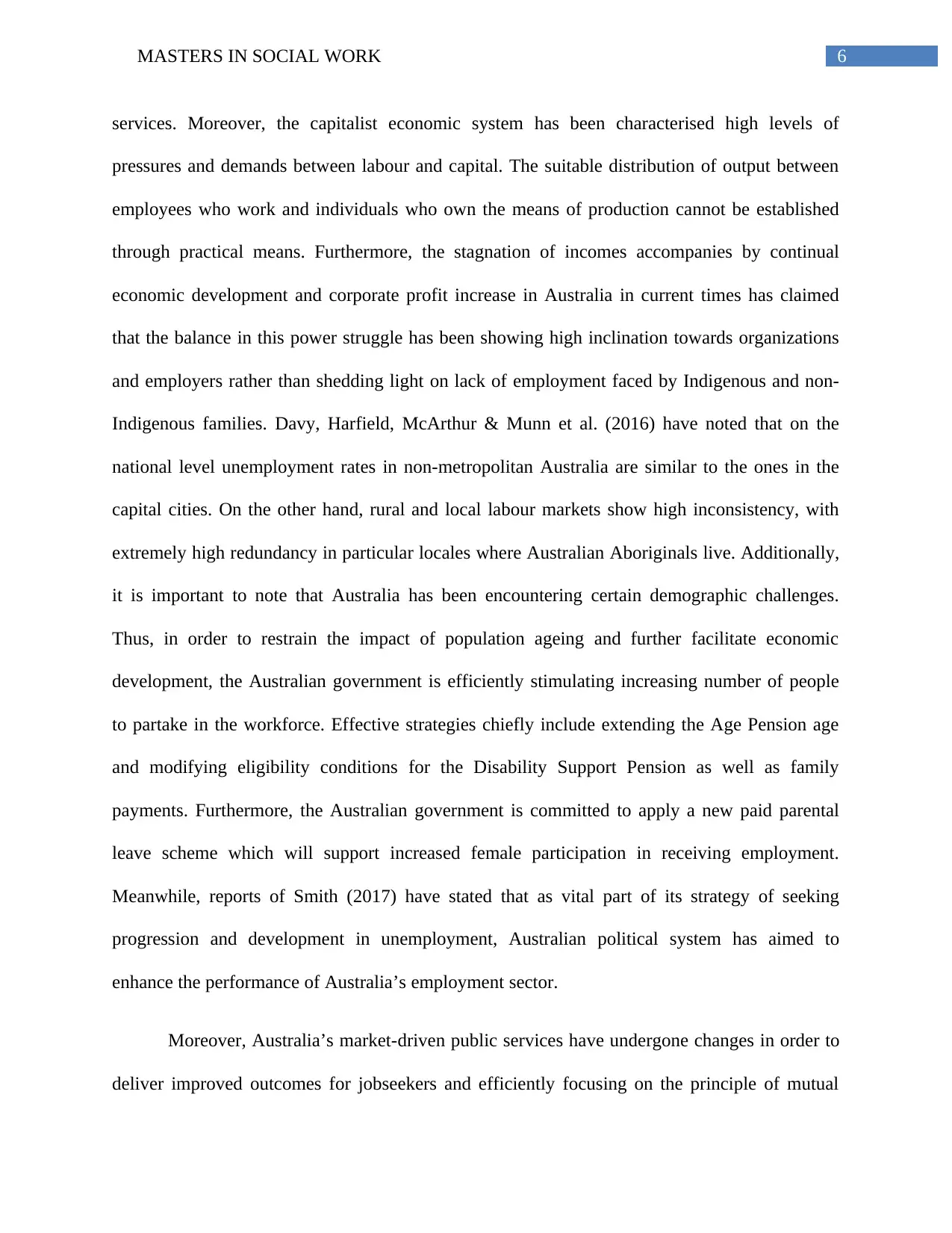
6MASTERS IN SOCIAL WORK
services. Moreover, the capitalist economic system has been characterised high levels of
pressures and demands between labour and capital. The suitable distribution of output between
employees who work and individuals who own the means of production cannot be established
through practical means. Furthermore, the stagnation of incomes accompanies by continual
economic development and corporate profit increase in Australia in current times has claimed
that the balance in this power struggle has been showing high inclination towards organizations
and employers rather than shedding light on lack of employment faced by Indigenous and non-
Indigenous families. Davy, Harfield, McArthur & Munn et al. (2016) have noted that on the
national level unemployment rates in non-metropolitan Australia are similar to the ones in the
capital cities. On the other hand, rural and local labour markets show high inconsistency, with
extremely high redundancy in particular locales where Australian Aboriginals live. Additionally,
it is important to note that Australia has been encountering certain demographic challenges.
Thus, in order to restrain the impact of population ageing and further facilitate economic
development, the Australian government is efficiently stimulating increasing number of people
to partake in the workforce. Effective strategies chiefly include extending the Age Pension age
and modifying eligibility conditions for the Disability Support Pension as well as family
payments. Furthermore, the Australian government is committed to apply a new paid parental
leave scheme which will support increased female participation in receiving employment.
Meanwhile, reports of Smith (2017) have stated that as vital part of its strategy of seeking
progression and development in unemployment, Australian political system has aimed to
enhance the performance of Australia’s employment sector.
Moreover, Australia’s market-driven public services have undergone changes in order to
deliver improved outcomes for jobseekers and efficiently focusing on the principle of mutual
services. Moreover, the capitalist economic system has been characterised high levels of
pressures and demands between labour and capital. The suitable distribution of output between
employees who work and individuals who own the means of production cannot be established
through practical means. Furthermore, the stagnation of incomes accompanies by continual
economic development and corporate profit increase in Australia in current times has claimed
that the balance in this power struggle has been showing high inclination towards organizations
and employers rather than shedding light on lack of employment faced by Indigenous and non-
Indigenous families. Davy, Harfield, McArthur & Munn et al. (2016) have noted that on the
national level unemployment rates in non-metropolitan Australia are similar to the ones in the
capital cities. On the other hand, rural and local labour markets show high inconsistency, with
extremely high redundancy in particular locales where Australian Aboriginals live. Additionally,
it is important to note that Australia has been encountering certain demographic challenges.
Thus, in order to restrain the impact of population ageing and further facilitate economic
development, the Australian government is efficiently stimulating increasing number of people
to partake in the workforce. Effective strategies chiefly include extending the Age Pension age
and modifying eligibility conditions for the Disability Support Pension as well as family
payments. Furthermore, the Australian government is committed to apply a new paid parental
leave scheme which will support increased female participation in receiving employment.
Meanwhile, reports of Smith (2017) have stated that as vital part of its strategy of seeking
progression and development in unemployment, Australian political system has aimed to
enhance the performance of Australia’s employment sector.
Moreover, Australia’s market-driven public services have undergone changes in order to
deliver improved outcomes for jobseekers and efficiently focusing on the principle of mutual
Paraphrase This Document
Need a fresh take? Get an instant paraphrase of this document with our AI Paraphraser
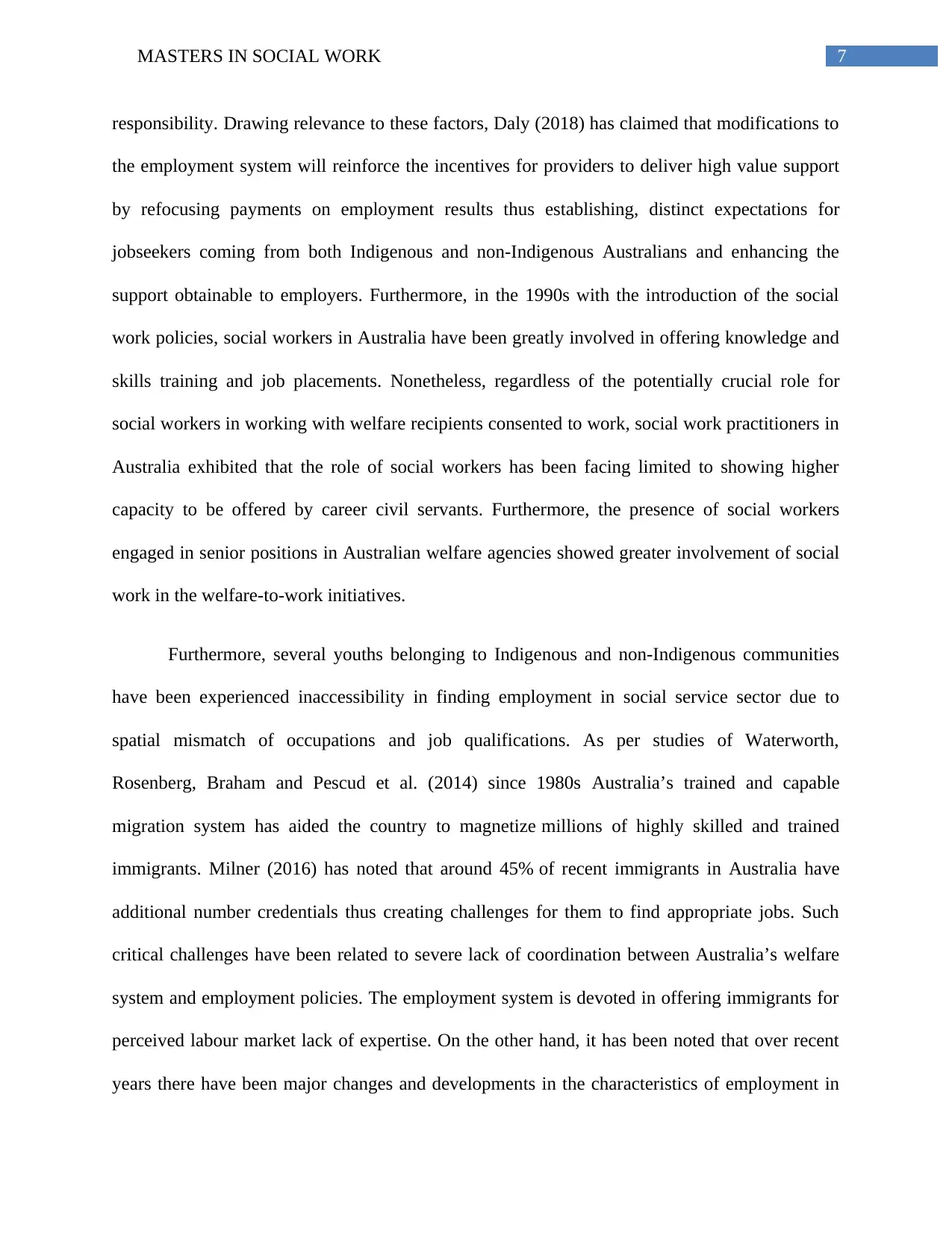
7MASTERS IN SOCIAL WORK
responsibility. Drawing relevance to these factors, Daly (2018) has claimed that modifications to
the employment system will reinforce the incentives for providers to deliver high value support
by refocusing payments on employment results thus establishing, distinct expectations for
jobseekers coming from both Indigenous and non-Indigenous Australians and enhancing the
support obtainable to employers. Furthermore, in the 1990s with the introduction of the social
work policies, social workers in Australia have been greatly involved in offering knowledge and
skills training and job placements. Nonetheless, regardless of the potentially crucial role for
social workers in working with welfare recipients consented to work, social work practitioners in
Australia exhibited that the role of social workers has been facing limited to showing higher
capacity to be offered by career civil servants. Furthermore, the presence of social workers
engaged in senior positions in Australian welfare agencies showed greater involvement of social
work in the welfare-to-work initiatives.
Furthermore, several youths belonging to Indigenous and non-Indigenous communities
have been experienced inaccessibility in finding employment in social service sector due to
spatial mismatch of occupations and job qualifications. As per studies of Waterworth,
Rosenberg, Braham and Pescud et al. (2014) since 1980s Australia’s trained and capable
migration system has aided the country to magnetize millions of highly skilled and trained
immigrants. Milner (2016) has noted that around 45% of recent immigrants in Australia have
additional number credentials thus creating challenges for them to find appropriate jobs. Such
critical challenges have been related to severe lack of coordination between Australia’s welfare
system and employment policies. The employment system is devoted in offering immigrants for
perceived labour market lack of expertise. On the other hand, it has been noted that over recent
years there have been major changes and developments in the characteristics of employment in
responsibility. Drawing relevance to these factors, Daly (2018) has claimed that modifications to
the employment system will reinforce the incentives for providers to deliver high value support
by refocusing payments on employment results thus establishing, distinct expectations for
jobseekers coming from both Indigenous and non-Indigenous Australians and enhancing the
support obtainable to employers. Furthermore, in the 1990s with the introduction of the social
work policies, social workers in Australia have been greatly involved in offering knowledge and
skills training and job placements. Nonetheless, regardless of the potentially crucial role for
social workers in working with welfare recipients consented to work, social work practitioners in
Australia exhibited that the role of social workers has been facing limited to showing higher
capacity to be offered by career civil servants. Furthermore, the presence of social workers
engaged in senior positions in Australian welfare agencies showed greater involvement of social
work in the welfare-to-work initiatives.
Furthermore, several youths belonging to Indigenous and non-Indigenous communities
have been experienced inaccessibility in finding employment in social service sector due to
spatial mismatch of occupations and job qualifications. As per studies of Waterworth,
Rosenberg, Braham and Pescud et al. (2014) since 1980s Australia’s trained and capable
migration system has aided the country to magnetize millions of highly skilled and trained
immigrants. Milner (2016) has noted that around 45% of recent immigrants in Australia have
additional number credentials thus creating challenges for them to find appropriate jobs. Such
critical challenges have been related to severe lack of coordination between Australia’s welfare
system and employment policies. The employment system is devoted in offering immigrants for
perceived labour market lack of expertise. On the other hand, it has been noted that over recent
years there have been major changes and developments in the characteristics of employment in
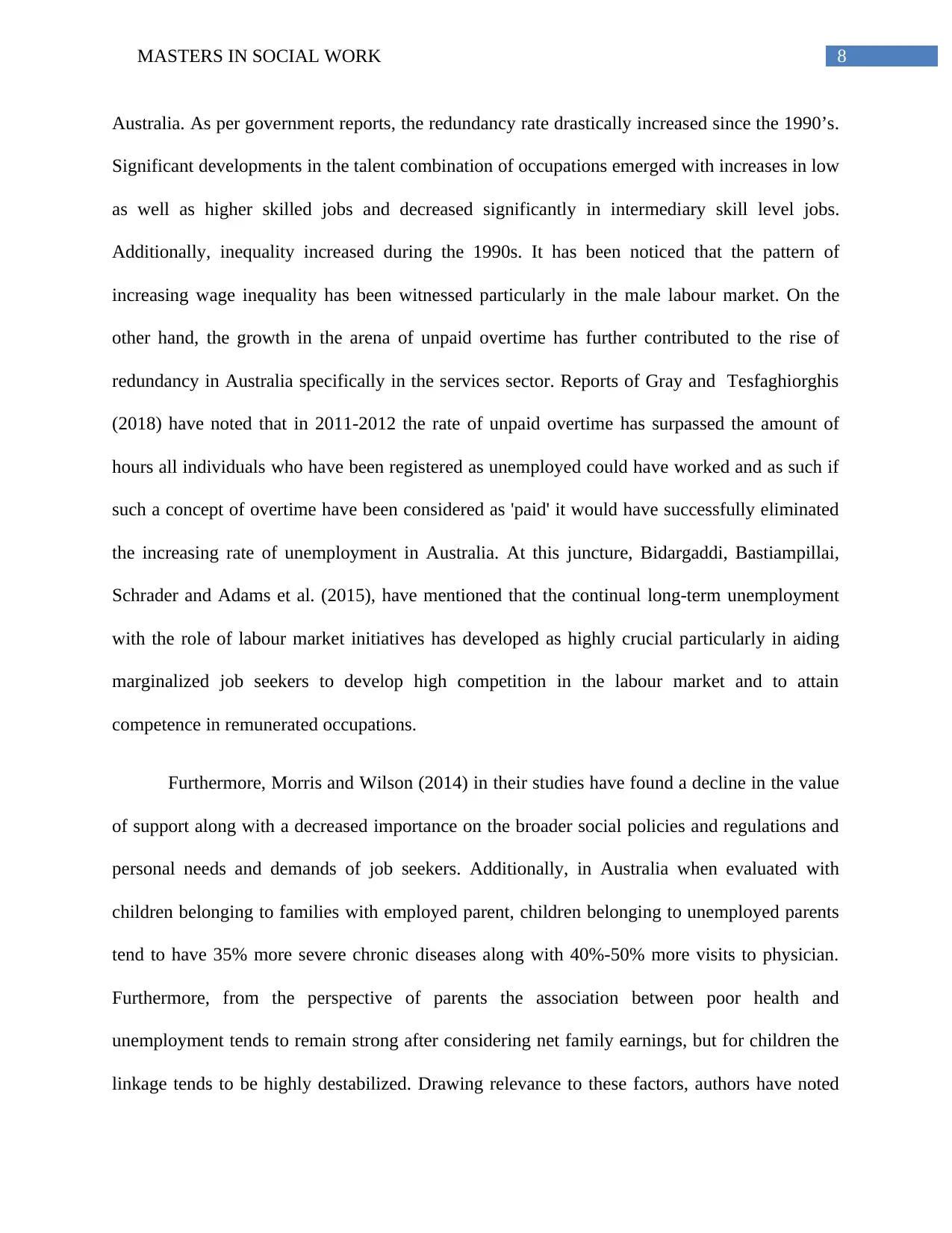
8MASTERS IN SOCIAL WORK
Australia. As per government reports, the redundancy rate drastically increased since the 1990’s.
Significant developments in the talent combination of occupations emerged with increases in low
as well as higher skilled jobs and decreased significantly in intermediary skill level jobs.
Additionally, inequality increased during the 1990s. It has been noticed that the pattern of
increasing wage inequality has been witnessed particularly in the male labour market. On the
other hand, the growth in the arena of unpaid overtime has further contributed to the rise of
redundancy in Australia specifically in the services sector. Reports of Gray and Tesfaghiorghis
(2018) have noted that in 2011-2012 the rate of unpaid overtime has surpassed the amount of
hours all individuals who have been registered as unemployed could have worked and as such if
such a concept of overtime have been considered as 'paid' it would have successfully eliminated
the increasing rate of unemployment in Australia. At this juncture, Bidargaddi, Bastiampillai,
Schrader and Adams et al. (2015), have mentioned that the continual long-term unemployment
with the role of labour market initiatives has developed as highly crucial particularly in aiding
marginalized job seekers to develop high competition in the labour market and to attain
competence in remunerated occupations.
Furthermore, Morris and Wilson (2014) in their studies have found a decline in the value
of support along with a decreased importance on the broader social policies and regulations and
personal needs and demands of job seekers. Additionally, in Australia when evaluated with
children belonging to families with employed parent, children belonging to unemployed parents
tend to have 35% more severe chronic diseases along with 40%-50% more visits to physician.
Furthermore, from the perspective of parents the association between poor health and
unemployment tends to remain strong after considering net family earnings, but for children the
linkage tends to be highly destabilized. Drawing relevance to these factors, authors have noted
Australia. As per government reports, the redundancy rate drastically increased since the 1990’s.
Significant developments in the talent combination of occupations emerged with increases in low
as well as higher skilled jobs and decreased significantly in intermediary skill level jobs.
Additionally, inequality increased during the 1990s. It has been noticed that the pattern of
increasing wage inequality has been witnessed particularly in the male labour market. On the
other hand, the growth in the arena of unpaid overtime has further contributed to the rise of
redundancy in Australia specifically in the services sector. Reports of Gray and Tesfaghiorghis
(2018) have noted that in 2011-2012 the rate of unpaid overtime has surpassed the amount of
hours all individuals who have been registered as unemployed could have worked and as such if
such a concept of overtime have been considered as 'paid' it would have successfully eliminated
the increasing rate of unemployment in Australia. At this juncture, Bidargaddi, Bastiampillai,
Schrader and Adams et al. (2015), have mentioned that the continual long-term unemployment
with the role of labour market initiatives has developed as highly crucial particularly in aiding
marginalized job seekers to develop high competition in the labour market and to attain
competence in remunerated occupations.
Furthermore, Morris and Wilson (2014) in their studies have found a decline in the value
of support along with a decreased importance on the broader social policies and regulations and
personal needs and demands of job seekers. Additionally, in Australia when evaluated with
children belonging to families with employed parent, children belonging to unemployed parents
tend to have 35% more severe chronic diseases along with 40%-50% more visits to physician.
Furthermore, from the perspective of parents the association between poor health and
unemployment tends to remain strong after considering net family earnings, but for children the
linkage tends to be highly destabilized. Drawing relevance to these factors, authors have noted
⊘ This is a preview!⊘
Do you want full access?
Subscribe today to unlock all pages.

Trusted by 1+ million students worldwide
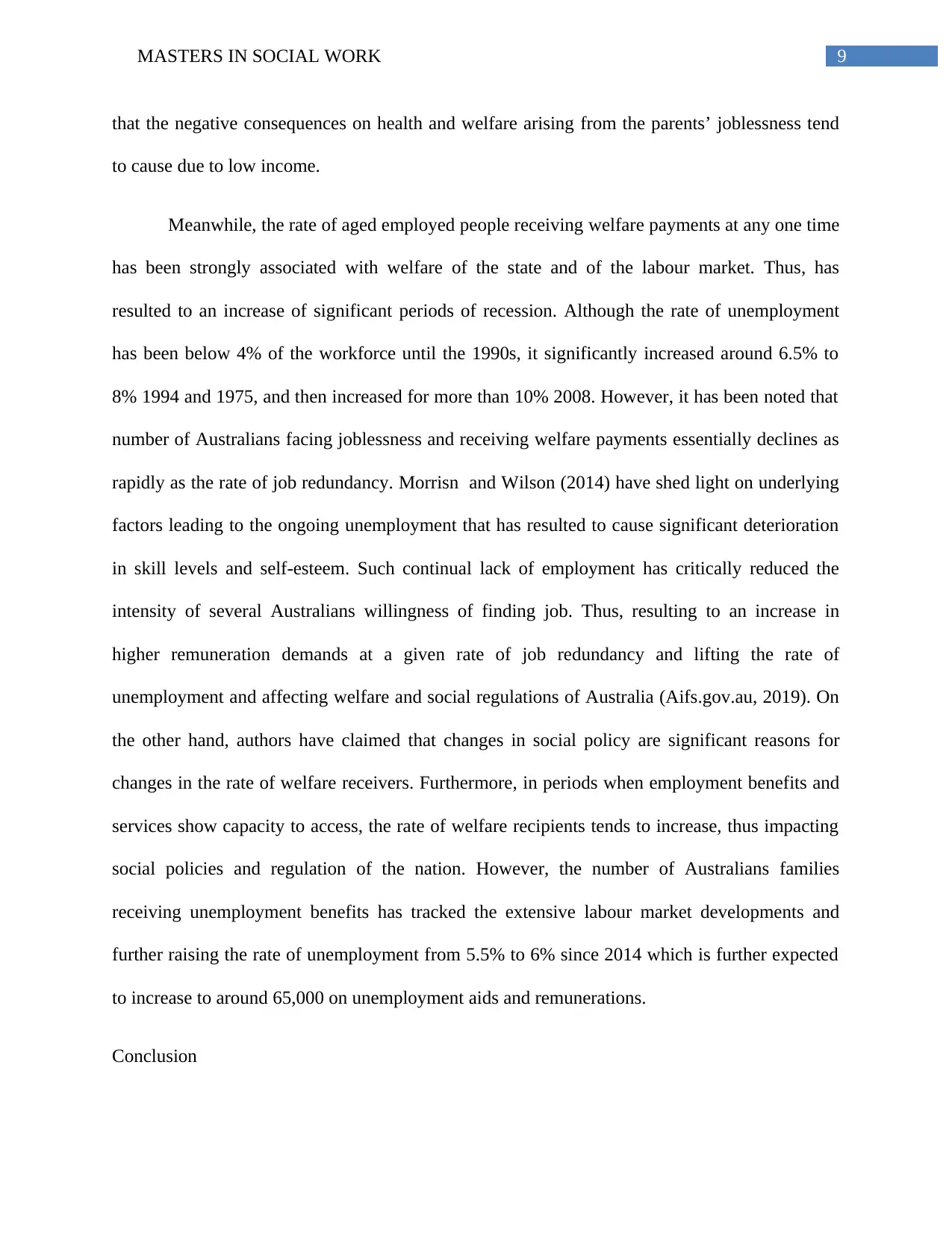
9MASTERS IN SOCIAL WORK
that the negative consequences on health and welfare arising from the parents’ joblessness tend
to cause due to low income.
Meanwhile, the rate of aged employed people receiving welfare payments at any one time
has been strongly associated with welfare of the state and of the labour market. Thus, has
resulted to an increase of significant periods of recession. Although the rate of unemployment
has been below 4% of the workforce until the 1990s, it significantly increased around 6.5% to
8% 1994 and 1975, and then increased for more than 10% 2008. However, it has been noted that
number of Australians facing joblessness and receiving welfare payments essentially declines as
rapidly as the rate of job redundancy. Morrisn and Wilson (2014) have shed light on underlying
factors leading to the ongoing unemployment that has resulted to cause significant deterioration
in skill levels and self-esteem. Such continual lack of employment has critically reduced the
intensity of several Australians willingness of finding job. Thus, resulting to an increase in
higher remuneration demands at a given rate of job redundancy and lifting the rate of
unemployment and affecting welfare and social regulations of Australia (Aifs.gov.au, 2019). On
the other hand, authors have claimed that changes in social policy are significant reasons for
changes in the rate of welfare receivers. Furthermore, in periods when employment benefits and
services show capacity to access, the rate of welfare recipients tends to increase, thus impacting
social policies and regulation of the nation. However, the number of Australians families
receiving unemployment benefits has tracked the extensive labour market developments and
further raising the rate of unemployment from 5.5% to 6% since 2014 which is further expected
to increase to around 65,000 on unemployment aids and remunerations.
Conclusion
that the negative consequences on health and welfare arising from the parents’ joblessness tend
to cause due to low income.
Meanwhile, the rate of aged employed people receiving welfare payments at any one time
has been strongly associated with welfare of the state and of the labour market. Thus, has
resulted to an increase of significant periods of recession. Although the rate of unemployment
has been below 4% of the workforce until the 1990s, it significantly increased around 6.5% to
8% 1994 and 1975, and then increased for more than 10% 2008. However, it has been noted that
number of Australians facing joblessness and receiving welfare payments essentially declines as
rapidly as the rate of job redundancy. Morrisn and Wilson (2014) have shed light on underlying
factors leading to the ongoing unemployment that has resulted to cause significant deterioration
in skill levels and self-esteem. Such continual lack of employment has critically reduced the
intensity of several Australians willingness of finding job. Thus, resulting to an increase in
higher remuneration demands at a given rate of job redundancy and lifting the rate of
unemployment and affecting welfare and social regulations of Australia (Aifs.gov.au, 2019). On
the other hand, authors have claimed that changes in social policy are significant reasons for
changes in the rate of welfare receivers. Furthermore, in periods when employment benefits and
services show capacity to access, the rate of welfare recipients tends to increase, thus impacting
social policies and regulation of the nation. However, the number of Australians families
receiving unemployment benefits has tracked the extensive labour market developments and
further raising the rate of unemployment from 5.5% to 6% since 2014 which is further expected
to increase to around 65,000 on unemployment aids and remunerations.
Conclusion
Paraphrase This Document
Need a fresh take? Get an instant paraphrase of this document with our AI Paraphraser
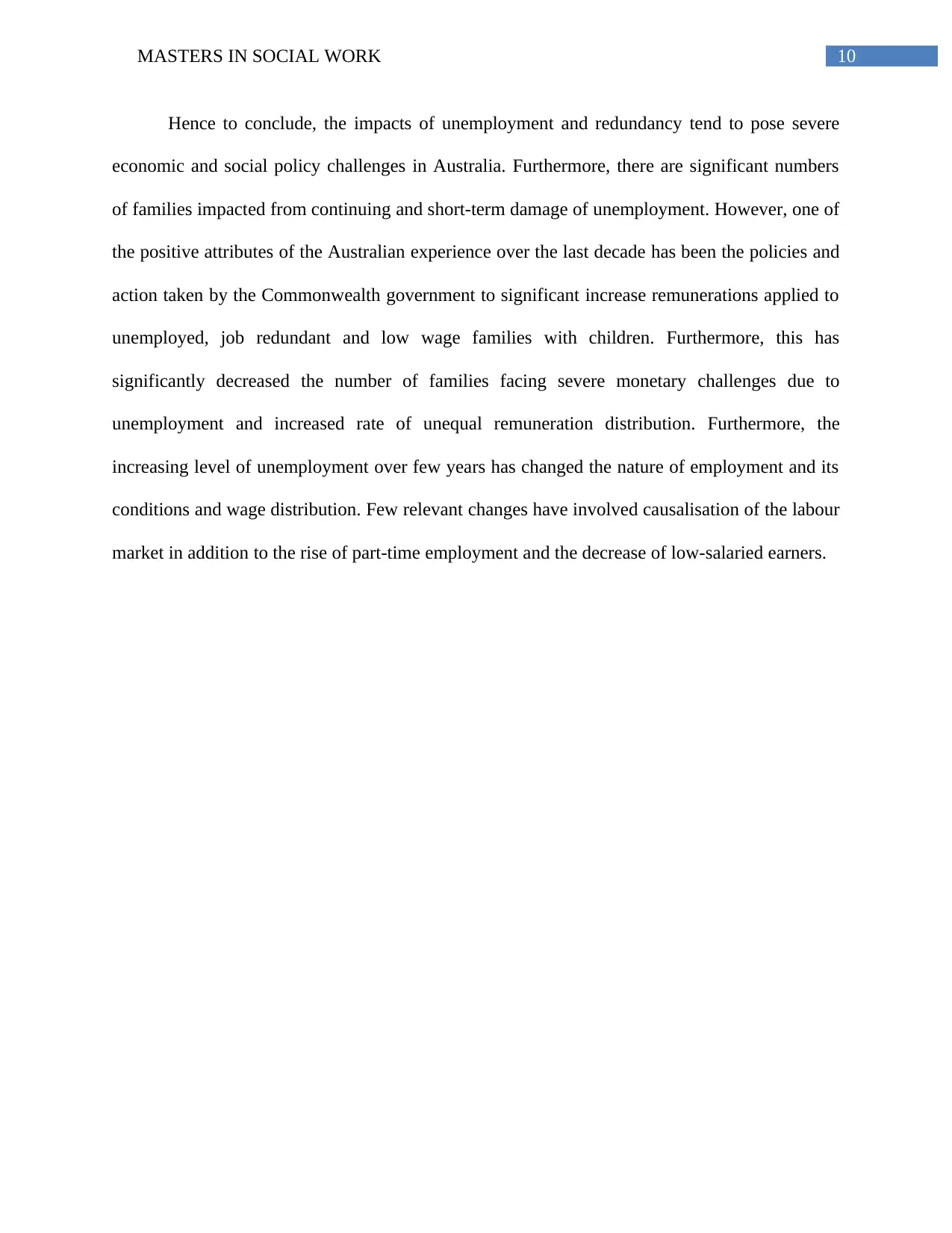
10MASTERS IN SOCIAL WORK
Hence to conclude, the impacts of unemployment and redundancy tend to pose severe
economic and social policy challenges in Australia. Furthermore, there are significant numbers
of families impacted from continuing and short-term damage of unemployment. However, one of
the positive attributes of the Australian experience over the last decade has been the policies and
action taken by the Commonwealth government to significant increase remunerations applied to
unemployed, job redundant and low wage families with children. Furthermore, this has
significantly decreased the number of families facing severe monetary challenges due to
unemployment and increased rate of unequal remuneration distribution. Furthermore, the
increasing level of unemployment over few years has changed the nature of employment and its
conditions and wage distribution. Few relevant changes have involved causalisation of the labour
market in addition to the rise of part-time employment and the decrease of low-salaried earners.
Hence to conclude, the impacts of unemployment and redundancy tend to pose severe
economic and social policy challenges in Australia. Furthermore, there are significant numbers
of families impacted from continuing and short-term damage of unemployment. However, one of
the positive attributes of the Australian experience over the last decade has been the policies and
action taken by the Commonwealth government to significant increase remunerations applied to
unemployed, job redundant and low wage families with children. Furthermore, this has
significantly decreased the number of families facing severe monetary challenges due to
unemployment and increased rate of unequal remuneration distribution. Furthermore, the
increasing level of unemployment over few years has changed the nature of employment and its
conditions and wage distribution. Few relevant changes have involved causalisation of the labour
market in addition to the rise of part-time employment and the decrease of low-salaried earners.
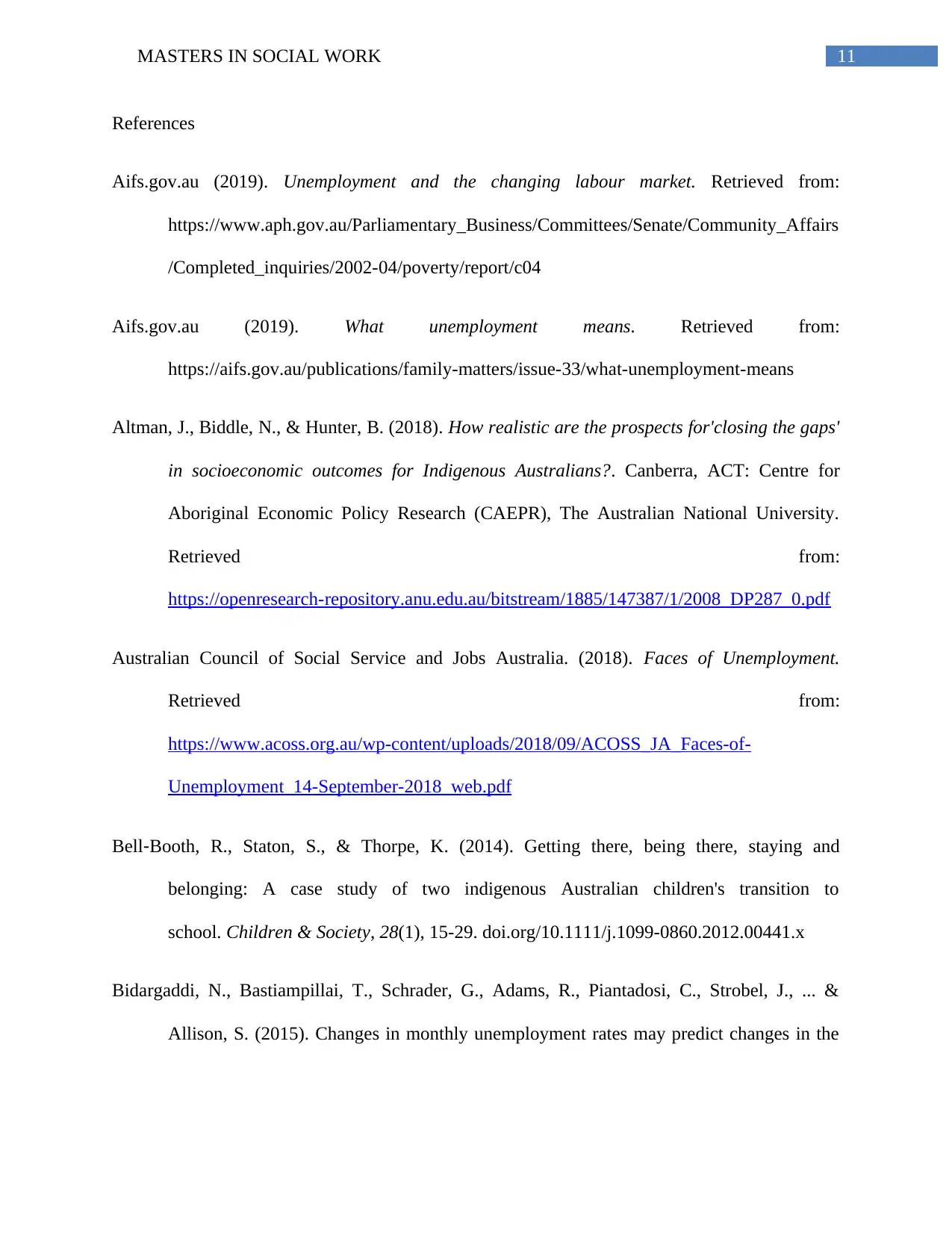
11MASTERS IN SOCIAL WORK
References
Aifs.gov.au (2019). Unemployment and the changing labour market. Retrieved from:
https://www.aph.gov.au/Parliamentary_Business/Committees/Senate/Community_Affairs
/Completed_inquiries/2002-04/poverty/report/c04
Aifs.gov.au (2019). What unemployment means. Retrieved from:
https://aifs.gov.au/publications/family-matters/issue-33/what-unemployment-means
Altman, J., Biddle, N., & Hunter, B. (2018). How realistic are the prospects for'closing the gaps'
in socioeconomic outcomes for Indigenous Australians?. Canberra, ACT: Centre for
Aboriginal Economic Policy Research (CAEPR), The Australian National University.
Retrieved from:
https://openresearch-repository.anu.edu.au/bitstream/1885/147387/1/2008_DP287_0.pdf
Australian Council of Social Service and Jobs Australia. (2018). Faces of Unemployment.
Retrieved from:
https://www.acoss.org.au/wp-content/uploads/2018/09/ACOSS_JA_Faces-of-
Unemployment_14-September-2018_web.pdf
Bell‐Booth, R., Staton, S., & Thorpe, K. (2014). Getting there, being there, staying and
belonging: A case study of two indigenous Australian children's transition to
school. Children & Society, 28(1), 15-29. doi.org/10.1111/j.1099-0860.2012.00441.x
Bidargaddi, N., Bastiampillai, T., Schrader, G., Adams, R., Piantadosi, C., Strobel, J., ... &
Allison, S. (2015). Changes in monthly unemployment rates may predict changes in the
References
Aifs.gov.au (2019). Unemployment and the changing labour market. Retrieved from:
https://www.aph.gov.au/Parliamentary_Business/Committees/Senate/Community_Affairs
/Completed_inquiries/2002-04/poverty/report/c04
Aifs.gov.au (2019). What unemployment means. Retrieved from:
https://aifs.gov.au/publications/family-matters/issue-33/what-unemployment-means
Altman, J., Biddle, N., & Hunter, B. (2018). How realistic are the prospects for'closing the gaps'
in socioeconomic outcomes for Indigenous Australians?. Canberra, ACT: Centre for
Aboriginal Economic Policy Research (CAEPR), The Australian National University.
Retrieved from:
https://openresearch-repository.anu.edu.au/bitstream/1885/147387/1/2008_DP287_0.pdf
Australian Council of Social Service and Jobs Australia. (2018). Faces of Unemployment.
Retrieved from:
https://www.acoss.org.au/wp-content/uploads/2018/09/ACOSS_JA_Faces-of-
Unemployment_14-September-2018_web.pdf
Bell‐Booth, R., Staton, S., & Thorpe, K. (2014). Getting there, being there, staying and
belonging: A case study of two indigenous Australian children's transition to
school. Children & Society, 28(1), 15-29. doi.org/10.1111/j.1099-0860.2012.00441.x
Bidargaddi, N., Bastiampillai, T., Schrader, G., Adams, R., Piantadosi, C., Strobel, J., ... &
Allison, S. (2015). Changes in monthly unemployment rates may predict changes in the
⊘ This is a preview!⊘
Do you want full access?
Subscribe today to unlock all pages.

Trusted by 1+ million students worldwide
1 out of 16
Related Documents
Your All-in-One AI-Powered Toolkit for Academic Success.
+13062052269
info@desklib.com
Available 24*7 on WhatsApp / Email
![[object Object]](/_next/static/media/star-bottom.7253800d.svg)
Unlock your academic potential
Copyright © 2020–2025 A2Z Services. All Rights Reserved. Developed and managed by ZUCOL.





